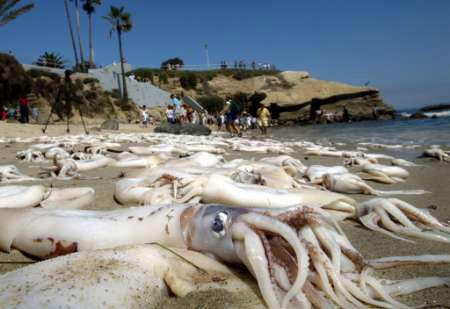|
| 질의: flying fish | 결과: 64번째/155 | |
2002-07-26 Thousands of Jumbo Squid washed ashore in California
| 제목: | 2002-07-26 Thousands of Jumbo Squid washed ashore in California
| | 올린이: | funny monster (from@funny.animal.photos)
| |

| 해상도: 450x309
파일크기: 24039 Bytes
등록시간: 2007:09:20 23:29:32
|
2002-07-26 Thousands of Jumbo Squid washed ashore in California
Thousands of jumbo flying squid (Dosidicus gigas) or Humboldt squid, were found stranded on southern California beaches over the summer of 2002. The normal range of these squid, also known as Humboldt squid, is from Peru north to Baja California. However, warm water events such as El Ni??o can extend the range of these squid to Oregon.
The first reported stranding was on July 18 at Swami’s Beach in Encinitas, CA, where approximately 200 squid were found over a mile stretch of shore. Their mantle lengths ranged from 16 to 24 inches, and they weighed between 2 and 2.5 pounds. On July 25, several thousand squid beached themselves at La Jolla Shores (pictured above), about 15 miles north of San Diego. Scientiests believe they squid were following prey, possibly grunion, a small fish, and washed ashore alive but were unable to get back into the water and died. City work crews were called to help remove tons of dead fish. |
^o^
동물그림창고 똑똑전화 누리집
^o^
|
|